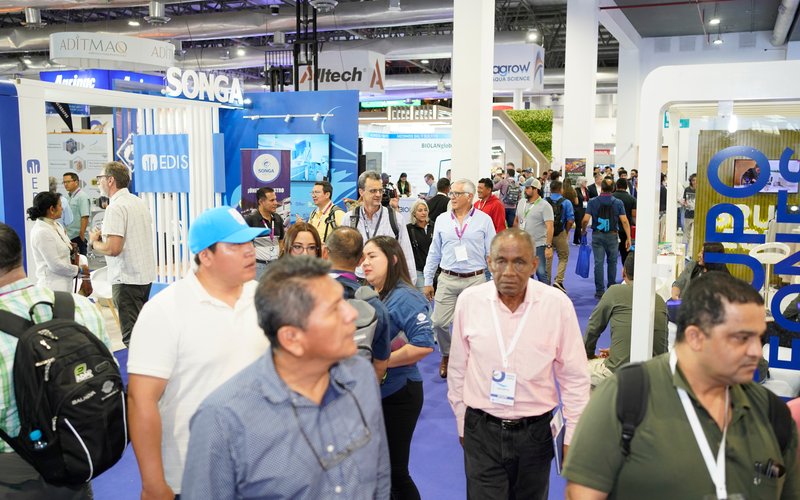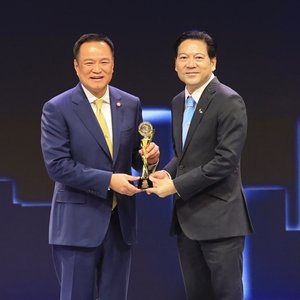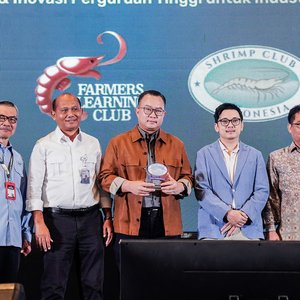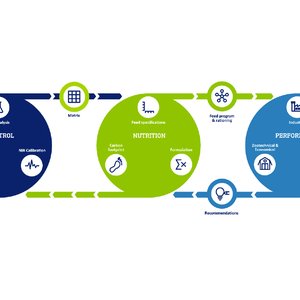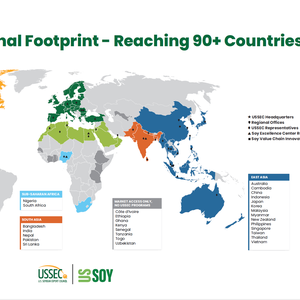With over 50 years of experience, Ecuador's shrimp industry is a mature sector in terms of production today. This has been made possible by a different cultivation scheme than that used in other countries, based on its own genetics, constantly reviewed management protocols, and sustained investment in animal nutrition. Over the last decade and a half, the industry has grown at an annual rate of 15% without needing to expand its aquaculture frontier, allowing Ecuador to consolidate itself as the largest shrimp producer and exporter in the world.
This growth has been accompanied by solid commercial management by processors and exporters. The United States and Europe were the main initial destinations, but in the past 12 years, China has become the primary market for Ecuadorian shrimp. "Today, 75% of shrimp imports in China come from Ecuador. This has allowed the sector to grow substantially in the past seven years," said José Antonio Camposano, Executive President of the National Chamber of Aquaculture (CNA), in an interview with Aquafeed.com.
Between 2019 and 2020, thanks to constant investments by the sector, Ecuador also climbed positions in the US market and is now the second-largest shrimp supplier to the country, getting closer and closer to India.
Competitiveness and challenges
Despite this growth, the sector's competitiveness is currently affected. Camposano highlights, firstly, that unlike other producing countries, Ecuador is a dollarized economy, which leaves it exposed to fluctuations in the dollar's strength or weakening.
Furthermore, for many years, Ecuador did not focus on its exports. While other neighboring countries were signing free trade agreements, Ecuador only recently began to catch up, seeking a fast track to negotiations with different nations.
"With a population of 18 million inhabitants, Ecuador cannot absorb more than 1% of its production, so it is obliged to place its supply in various international destinations. The shrimp sector annually exports to about 60 markets worldwide, which represents a huge effort, as each market demands a different shrimp format and specific standards. For example, in the past six years, the country has made large investments to reconfigure its industry and reach a volume that allows it to serve the US market," Camposano explained.
Added to this are the reciprocal tariffs from the Trump administration, at 15% in the case of Ecuador. "That means an additional challenge, because in the particular case of the United States, we pay all tariffs at the time of exporting the shrimp, unlike other destinations where we export FOB. This generates uncertainty, because the exporter must consider the possibility that tariffs may change over time," he added.
US tariff policy has effects that extend beyond foreign trade, impacting global economies and consumption. "Today, it's not just about producing and exporting shrimp, but about facing a series of factors that distort economic behavior and generate uncertainty," Camposano explained.
Domestically, policies agreed upon with the International Monetary Fund have eliminated electricity subsidies for "large consumers," increasing rates by 20% and affecting the entire shrimp value chain. Additionally, the withdrawal of the subsidy for vehicular diesel will have an additional impact on production costs.
The sector has reached a stage of maturity where maintaining growth is increasingly difficult. Until now, the response has been to increase efficiency through investments. "Today, with a more mature industry, we have diminishing returns, so those investments generate smaller returns, and the relief effect against rising costs, especially those we do not control, is also smaller," Camposano warned.
In 2025, the sector continues to grow. An increase close to 12% was registered up to August, pending what happens in the last quarter of the year. In addition to commercial challenges, the sector is closely following the evolution of the Chinese economy. "We were accustomed to a China that grew between 7% and 9%. Today, with growth between 3% and 4%, we must redouble our efforts to diversify our offerings and export destinations," he noted.
Technification
Ecuador is a clear example of how the technification of the ponds can lead to efficiency levels without the need to increase stocking density, which has been the trend in other producing countries.
"Ecuador continues to be a country with a semi-intensive scheme, but the industry is migrating towards precision aquaculture, where the producer ceases to be just a farmer and becomes an administrator," Camposano explained. "The level of global competitiveness, both financial and operational, leaves no room for artisanal shrimp farming due to the efficiency levels that must be achieved."
In this process, the concentration and integration of companies are becoming increasingly relevant. The sector is currently undergoing consolidation, with producers forming partnerships for export and exporters vertically integrating to produce as well.
Sustainability
Through the Sustainable Shrimp Partnership (SSP) initiative, Ecuador is working to improve its sustainability standards, including reducing marine ingredients in feed, migrating towards clean energy, and decreasing environmental impact on natural ecosystems.
Traceability is another aspect where Ecuador leads. Camposano especially highlights the responsible use of antibiotics: "Ecuador is almost the only country in the world that has no rejections, with a clean history in terms of detection or testing for shrimp medication. But this is a problem that other producers have not yet solved."
"Currently, the market trend is to demand animal welfare, and there is an intention to implement it as a new major requirement in industrial environments, when the problem of antibiotic use is not yet completely resolved globally, although it is in Ecuador. Antimicrobial resistance remains a public health problem to which we do not pay enough attention. I do not believe it is responsible to impose new demands without having resolved the pending issues. Sustainability is an evolving concept that obliges us to do better every day, but we must address what is pending before moving on to new topics," he stressed.
This commitment also extends to labor conditions. Work is underway in Ecuador to implement Living Wages, ensuring that all personnel receive a decent salary. "This year, at AquaExpo, we will present results from companies that have passed their second audit. I cannot conceive of an industry that discusses animal welfare while in some corners of the world, there is still talk of slavery in fishing or in aquaculture units. Who takes responsibility for the problems that remain unresolved in the countries of origin?" said Camposano.
AquaExpo, Ecuador's showcase
Ecuador and AquaExpo will be the global meeting point for aquaculture. From October 20 to 23, the Convention Center will welcome delegations from more than 20 countries in a high-impact global technical-commercial event.
"Aqua Expo is the main showcase for the Ecuadorian shrimp industry, a business opportunity, and a chance to show the country's productive model, which is different from the Asian one," said Yahira Piedrahita, Executive Director of the National Chamber of Aquaculture.
This year, the International Technical Congress will incorporate technological innovations in its presentations, with more than 60 national and foreign speakers. Topics to be discussed include efficient production, shrimp health and nutrition management, water and soil quality, production systems, market trends, and digital innovation applied to the industry.
As an inaugural session, this edition of AquaExpo will feature a former NASA official presenting on how various technologies developed for aerospace exploration have been applied to productive activities, such as aquaculture. "The Ecuadorian industry has always been receptive to new technologies. Examples of this are communication systems, remote sensors, and satellite images to estimate biomass, nutrients, soil types and coverage, originally conceived for space travel," explained Piedrahita.
The program will also include a session dedicated to market trends, where specialists will analyze consumer preferences in Asia, Europe, and the United States, the products in most significant demand depending on the season, and price evolution.
In parallel, and for the second consecutive year, Race To The Top will be held, a space that addresses global sustainability challenges, with the participation of business leaders, international organizations, and experts on the subject. The event will include presentations, panels, and workshops, and will feature the participation of the salmon industry from Chile through the Salmon Council (Consejo del Salmón). The event is aimed at executives and those responsible for strategic decision-making.
The AquaExpo International 2025 Trade Fair is also growing in this edition: it will be expanded to two floors of the exhibition center, totaling 8,000 m². More than 200 exhibiting companies will present the most innovative products, services, and technological solutions for the aquaculture sector. Delegations from shrimp-producing countries such as Mexico, Brazil, India, Thailand, and China are expected to visit, the latter being both Ecuador's primary market and a supplier of inputs. "We are working enthusiastically to surpass what was achieved last year," Piedrahita said.
With an estimated daily attendance of over 10,000 visitors, AQUAEXPO International 2025 is poised to become the premier platform for knowledge exchange, innovation, and business in the global aquaculture industry. "For an event focused almost exclusively on shrimp, that audience is a challenge and a source of pride, as it reflects the global interest in the Ecuadorian industry, which has led world exports in recent years. Furthermore, it represents an opportunity for networking, business, and recruitment, with an impact that transcends the entire region," added Piedrahita.
Find more information about the event here.


